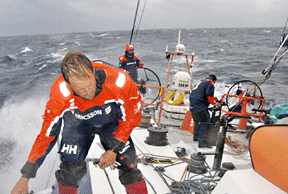
|
Volume XVII, Issue 7 - February 12 - February 18, 2009
|
|
Columns Reviews |
Fast Boats to China
The Volvo Ocean Race, Leg 4
by Steve Carr
After three fearsome legs of the Volvo Ocean Race, from Spain to Singapore, covering almost 13,000 miles, the lead boat Ericsson 4 was befouled by bureaucracy from the Rule Management Group and Chief Measurer.
|
|
![]() In the end, the charges were dismissed, and Singapore’s in-port race vindicated the crew. The short course around harbor was a battle royale, with American boat Puma winning the first race and Ericsson 4 finishing second; then Ericsson 4 winning the second race and Puma finishing a disappointing fourth.
In the end, the charges were dismissed, and Singapore’s in-port race vindicated the crew. The short course around harbor was a battle royale, with American boat Puma winning the first race and Ericsson 4 finishing second; then Ericsson 4 winning the second race and Puma finishing a disappointing fourth.
So after Singapore, Ericsson 4 expanded her lead over the rest of the fleet, while Puma gained a point on second-place Telefonica Blue.
Then it was off to China, for what proved to be the most difficult Volvo ocean leg ever.
The Siberian High
The race to Qingdao was a textbook in changing latitudes and survival sailing. Heading north through the South China Sea into the teeth of winter, the boats lost two hours of daylight each day as the temperatures plummeted. Two layers of clothing turned into seven, making a trip up on deck a major production. The upwind sailing was similar to the bone-jarring conditions of the North Atlantic, except that this was all new. No Volvo boat had ever raced this route before.
“The Siberian high is the primary system driving the weather,” reported team meteorologist Chris Bedford. “It’s basically an extension of the cold air from the North Pole, but the water temperature over most of the course will be warm. The pressure changes quickly between the cold air and warm water, and where it changes quickly you get lots of wind.”
The one bright spot was the leg’s relatively short length of 2,500 miles. Over that distance, weight was not a factor, so each boat loaded up the heaters, warm clothes and extra food.
The first part of the leg was a drag race, with all the boats bunched together, snap-tacking around atolls, reefs, and islands — many uncharted.
Puma skipper Ken Read explained his fear and frustration after a long day of dodging obstacles in shifty winds. “The water depth goes from 1,000 meters to three meters. Really fun at night especially. A little skill and a lot of luck. Both are needed.”
The Killer at Manila
The weather models showed a killer storm looming to the north, so the race officials added a safety waypoint at the last minute, requiring each boat to hug the sheltering west coast of Manila in the Philippines rather than sail out into rougher seas.
By the fifth day, all hell broke loose. Green Dragon was the first casualty, breaking a forestay in the rough upwind conditions and almost losing her mast. Winds were gusting up to 50 knots as the northerly flowing Kuoshio Current hit the wind wall and created 40-foot seas. Entering the 250-mile-wide Luzon Strait wind tunnel between the Philippines and Taiwan, the boats hoisted their storm jibs and braced for disaster.
They did not have long to wait.
Puma’s boom broke in half. Then the Spanish boat Telefonica Black cracked her hull and began taking on water. Delta Lloyd smashed her steering wheel, shredded her main sail and damaged her mast track. And Green Dragon’s forward ring frame disintegrated and separated from the hull. Each boat sought shelter in the Philippines. Black and Lloyd dropped out rather than risk sinking.
|
|
![]() Meanwhile, back in the Luzon Strait, the Dutchman Bouwe Bekking and the lads on Telefonica Blue bet the ranch and headed into open water while the Ericsson twins played it safe and hugged the coast of Taiwan. This choice proved to be the tactical difference in the race.
Meanwhile, back in the Luzon Strait, the Dutchman Bouwe Bekking and the lads on Telefonica Blue bet the ranch and headed into open water while the Ericsson twins played it safe and hugged the coast of Taiwan. This choice proved to be the tactical difference in the race.
In the spirit of the Chinese New Year, Puma and Green Dragon miraculously sailed back into the race after making quick repairs. After midnight the next day, second-place Ericsson 3 began to sink when a 12-foot-long crack suddenly appeared in her forward hull. She would make it safely to Taiwan, but she was out of the race.
Across the Yellow Sea
The final part of the odyssey was a crippled sprint across the Yellow Sea, with Telefonica Blue taking line honors while skipper Bouwe Bekking suffered down below in his bunk after popping out his back lugging sails. Ericsson 4 continued her string of hard-luck finishes, tangled in gigantic fishing nets off the Chinese coast. While her crew changed sails to back free, the wounded cat Puma stole second without a boom.
So after four murderous legs, Ericsson 4 clings tenaciously atop the leader board with 45 points, followed by Telefonica Blue with 41.5, and Puma in third with 38.
What’s Next?
Leg 5 begins this week, on February 14. This is a 13,000-mile leg that will take almost a month; no one knows how long for sure because they have never done anything like this before.

